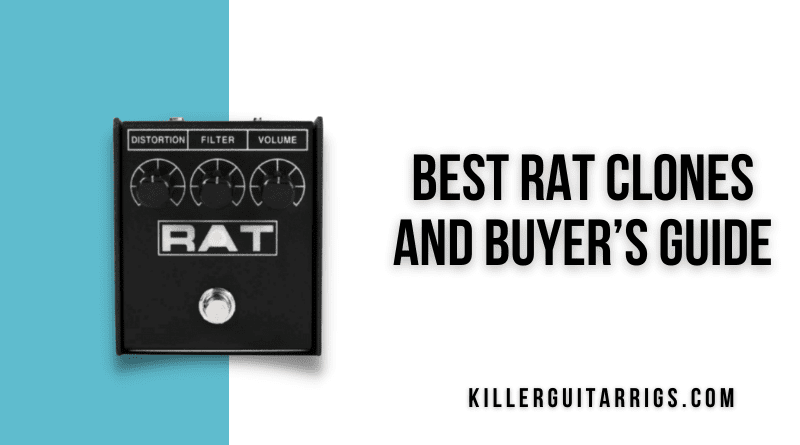Want the legendary sound of The RAT in a modern package? There are over a dozen RAT clones on the market, and not all of them can emulate the original.
That’s why we’ve researched and tested to come up with this list of the 5 Best RAT Clone pedals you can buy today.
To pick the best RAT clone pedals on the market, we compared different pedals to the original Pro Co RAT and to each other.
We used the same guitar (a Gibson Les Paul Studio) and amplifier (a Marshall Jubilee 100) for all the tests and kept the settings on the pedals comparable. We even did a blindfold test to make sure we weren’t biased and relied only on our ears.
Also included is a quick buyer’s guide, so you’ll be able to select the right pedal for your pedalboard and get that perfect tone you’ve been chasing. Read on and take your pick!
Read more about our review process.

Walrus Audio Iron Horse LM308 V3
Features: Variable clipping control, Level/Tone/Distortion preamp controls, True bypass switching
Benefits: Thick high gain tones, Super sturdy construction, User friendly operation
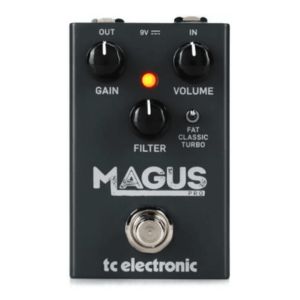
TC Electronic Magus Pro
Features: Fat/Classic/Turbo switch, Treble Filter control, All analog circuit
Benefits: Same control layout as original RAT, Warm vintage tones, Real time clipping feedback
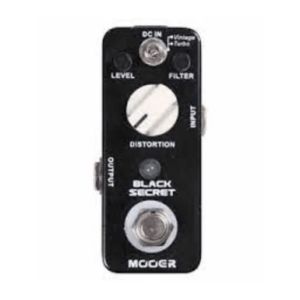
Mooer Black Secret
Features: Vintage/Turbo modes, All metal housing, Level/Filter/Distortion controls
Benefits: Extremely close to RAT tones, Takes up minimal pedal board room, Super affordable
Contents
Our Top 3
The TC Electronic Magus Pro offers by far the best bang for your buck in this category. It not only sounds great, but is more versatile and practical than many of its larger and costlier counterparts, making it our Top Pick.
The Mooer Black Secret is our Best Budget pick. You simply cannot find a RAT pedal in a more compact or cost-effective form than this.
And if money is no object, the Walrus Audio Iron Horse is our Editor’s Choice. It does everything the original pedal did, but better, although it’ll leave a sizable hole in your pocket.
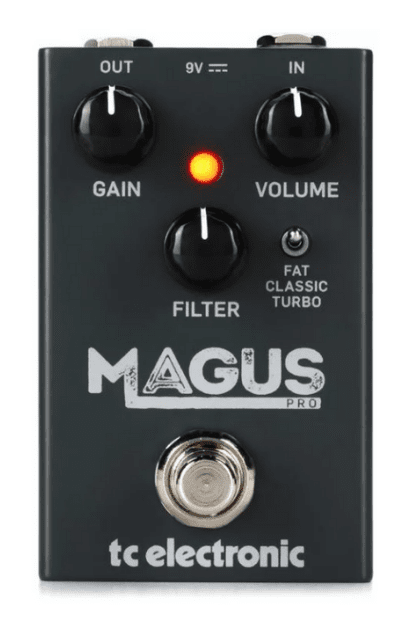
TC Electronic Magus Pro
The Magus Pro features a pocket LM-308, which sounds suspiciously RAT-like.
This pedal nets you a great combination of tone, price, and functionality, and sounds almost indistinguishable from the original ProCo RAT. It's simple to use, and built to last.
The Magus Pro by TC Electronic is the best RAT clone pedal considering quality, sound, practicality, and versatility. The TC Electronic Magus Pro guitar pedal delivers a full-bodied, rich tone that sounds like it was recorded in a live recording studio. If you’re a fan of the famous LM308 circuit from the 1980’s original RAT, you know how powerful this little pedal can be.
The Magus Pro pedals are based on the LM308, a high-gain distortion circuit with some upgrades. It features 3 analog knobs and 3 straightforward modes for tweaking your sound.
The Magus Pro’s Gain knob lets you control the pedal’s output, while the Volume knob lets you control the signal’s volume. Finally, the Filter knob enables you to adjust the pedal’s frequency response, shaping the highs as you need them.
We really liked the 3-way fat/classic/turbo switch, which gave us quick and effective control over the sound.
In Turbo mode, we were able to dial in the crunchy, growling mids and lows that RATs are so famous for. In Classic mode, we found we were able to get those sweet and smooth tones you know and love from your favorite overdrive pedals. Fat mode gave us a great, beefy, thick sound with a lot of grit.
We found the Magus Pro’s build quality to be excellent. It felt solid and the metal pots were easy to adjust. The compact design means that it can easily fit most pedalboards. The true bypass circuit was effective and really preserved our tone when the pedal was switched off.
Overall, this pedal offers exceptional value and it sounds great too. It delivers a warm, rich tone with plenty of headroom that combines perfectly with most amplifiers.
Verdict: The TC Electronic Magus Pro is ideal for all your high-distortion needs. It’s far more versatile than the original RAT and makes less noise. It is also inexpensive, solidly built, and compact in form. The various settings mean the dreadful lack of variety among RAT clones won’t lead to a stale sound with the Magus, which gives it a competitive edge. It also mixes well with other pedals.
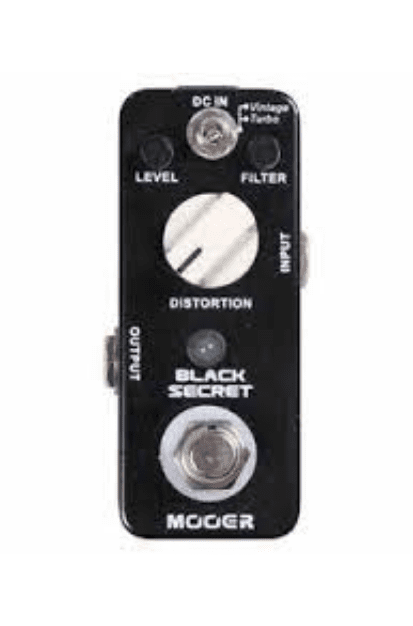
Mooer Black Secret
The Black Secret’s dual modes offer remarkable power on a budget.
If pedalboard space is at a premium for you, this compact pedal is a great option. It offers an authentic RAT sound and feel at a fraction of the cost.
Although not that much cheaper than the Magus, we found the Mooer Black Secret to be a great budget option for a RAT clone. This mini-wonder can be found online for just under 50 dollars.
Unlike the Magus, the Black Secret was actually explicitly designed with the original RAT as a template. It has two modes to switch back and forth, namely vintage and turbo.
The vintage mode gave us an old-school vibe with warm tones, while the turbo (named after the Turbo RAT) provided more than twice the maximum output compared to the vintage. The Black Secret’s gain is fully saturated, but we still felt a sharp edge and a tremendous bite in its sound.
The all-metal pots offer durability in an extremely compact design. This pedal is so tiny that it doesn’t even have a battery compartment in it! We had to plug it into a 9V DC power supply to run this pedal.
The circuit has true bypass and the all-analog setup gave us a warm and smooth sound. There are three controls, one central knob for distortion, and two more for level and filter. We used the filter to cut out nasty top-end noises, which resulted in a pristine distortion effect.
We could tell the sound from the pedal was pretty compressed, but it bloomed to give a satisfying result as we cranked up the distortion. There was some noise as we turned up the gain, but nothing that would make it unusable.
Verdict: The Black Secret is a worthy competitor to all the expensive RAT clones on the market. It mimics the sound of the original RAT pedal and adds its own twist with its Vintage and Turbo modes. However, it is a bit noisy and it doesn’t run on batteries.
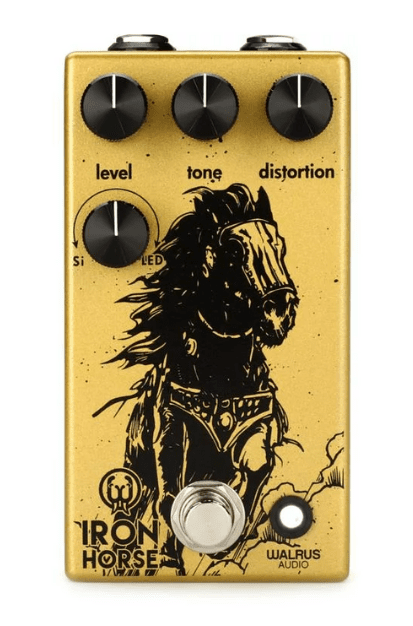
Walrus Audio Iron Horse
A true workhorse that will handle anything from overdrive to fuzz and everything in between.
This pedal isn't trying to look like a RAT, but it absolutely sounds like one. It offers simple operation, rugged build quality, and a number of great features.
If you’re searching for a great distortion pedal that will give you a lot of gain with tons of character, look no further. The Walrus Audio Iron Horse offers just that, and more.
The Iron Horse is a true monster when it comes to gain. It carried our tone as an overdrive when the gain was low and morphed into a pervasive, heavy fuzz as we turned it up. We found the Iron Horse to be the most versatile of all the pedals on this list.
It’s not a mere RAT clone; it’s an iconic distortion pedal in its own right.
The three knobs are for level, tone, and distortion settings, while the switch is for the three available compression modes (clipping diodes).
When the switch is turned to the left, it gives moderate compression. In the center, it provides high compression. To the right, it removes all compression. This allowed us to fine-tune the sound to our liking and adjust it according to our picking style.
It is also quite the looker. It’s a pedal that belongs on the pedalboard of a truly legendary guitar player. If you’re looking for a killer pedal that will give you rich, meaty tones, this is the one for you.
The Iron Horse V2 was an improvement over the original, with better level, tone, and distortion controls for a smoother experience. But Walrus Audio recently released the Iron Horse V3 with even more updates.
The V3 has done away with the switch for the different modes. Instead, it opts for a knob for the compression level and other characteristics that the mode switch was responsible for. The knob allows for a continuous change in the sound, allowing for even more fine-tuning.
Verdict: This distortion pedal from Walrus Audio is an absolute beast. It has all the features you can ask for – a ton of gain, great sound, true bypass, and even comes with a rugged metal chassis. Plus, it looks gorgeous. It certainly will leave a burning hole in your pocket, but with the artisan quality you get, it’s absolutely worth it.
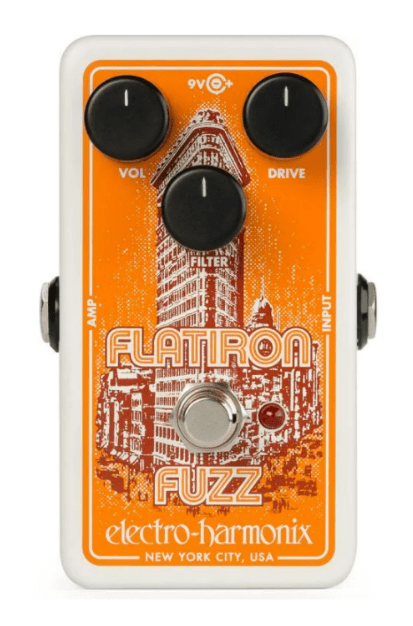
Electro-Harmonix Flat Iron Fuzz
True to the original RAT, down to every possible detail.
With this compact pedal, you're getting a faithful replica of the RAT, but thanks to the exterior design, it never feels like a clone or a copy. Being Electro Harmonix, it's extremely well made, sounds great, and would be a welcome addition to any pedal board.
The Electro-Harmonix Flatiron Fuzz is a compact pedal that can be used with various guitar sounds and is a perfect fit for any pedalboard. We found the Flatiron Fuzz to be suitable for both low distortion, clean tones and really high-gain tones for hard rock and heavy metal.
Much like the Pro Co RAT 2, the pedal has three control knobs for volume, filter, and drive. The filter knob allowed us to dial in just the right amount of high-end treble, and the drive controlled the distortion and sustain.
The center knob is a low pass filter and adjusting the knob sets the cutoff for the filter. The controls are similar to the RAT 2 and the sound is nearly identical. But this EHX pedal does have a character of its own and certainly holds up better on low-distortion settings than other counterparts.
The Flatiron Fuzz looks terrific with its vibrant orange body and the depiction of a city skyline on the face of the pedal. It features a smaller chassis than most pedals, hence it requires an external power supply and does not work on batteries.
The pedal is quite noisy when switched on, but it is a fuzz pedal, after all. Finding a group of compatible pedals for Flatiron Fuzz was a hassle, as RAT pedals generally do not stack nicely. It’s also more expensive than many other counterparts, but holds its own with a unique RAT flavor.
Verdict: The Electro-Harmonix Flatiron Fuzz comes pretty close to nailing the sound of the original RAT. The power supply is included with every pedal purchase, unlike other small pedals on this list. It’s very versatile and perfect for a variety of guitar sounds. So if you’re looking for something to add some extra distortion to your rig, then the Flatiron Fuzz is definitely worth checking out.
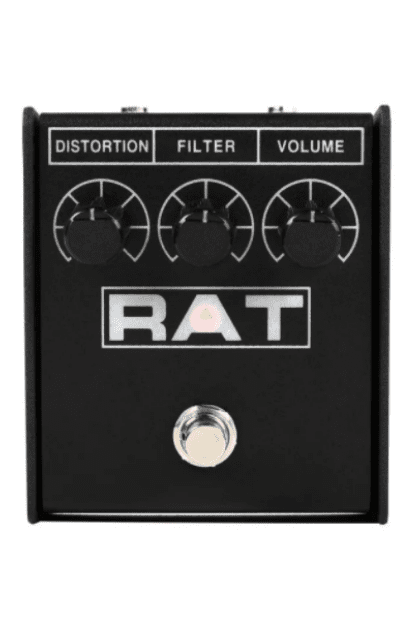
ProCo RAT 2
The original RAT, upgraded for the modern guitarist.
If authenticity is important to you, why not consider the real deal? The ProCo RAT 2 offers everything the original did, and more. It can take batteries or 9v power, it features a steel chassis for superb durability, and it even boasts glow in the dark graphics for easy viewing on dark stage.
If you’re looking for a RAT clone, could anything beat the original?
The Pro Co RAT 2 continues the legacy of the legendary RAT pedal over forty years after its creation. It offers a traditional tone with modern flexibility.
The RAT 2 is an exact replica of one of the most well-known distortion pedals in rock and metal. It’s the go-to choice for any rock guitarist who needs a distortion pedal that’s versatile, easy to use, and reliable.
It sounds amazing, works flawlessly, and it’s straightforward to dial in the right tone. This is because of its all-analog, military-spec glass-epoxy circuit board and the simplicity of its controls.
There are three knobs for distortion, filter, and volume. We used it to distort our tone beyond rhyme or reason and absolutely loved it. We were also able to get a nice warm overdrive after tuning it to perfection, instead of being limited to heavy fuzz. So it’d work for mellow blues, too.
The plastic body is supported by an all-steel chassis for exceptional durability. And best of all, the graphics on the face of the pedal glow in the dark! Never wonder what controls you’re messing with on a dark stage.
If you lack room on your pedalboard for a full-sized RAT, get a Lil’ RAT instead. It has all the functionality of the RAT 2 in a smaller package, though they had to remove the battery compartment to get it to this size.
The RAT 2 and Lil’ RAT sound and cost pretty much the same, so the decision depends on whether you will need the battery compartment or the extra room.
Verdict: The RAT 2 and its smaller identical twin, the Lil’ RAT, are affordable and relevant even today. Other than their signature sound, the pedals come with a 5-year warranty, though they are unlikely to let you down that quickly. The only problem with these pedals is they may not stack desirably with other pedals and are less versatile than modern clones.
How To Choose The Right Rat For You
With so many RAT clones on the market, it can be confusing to know which one is right for your pedalboard. Read through this quick guide to choose the best RAT clone for you:
What Tone Are You Looking For?
When purchasing a RAT distortion guitar pedal, knowing what kind of tone you want to achieve is essential. Some guitarists prefer bright, edgy tones that give them a jolt. Others prefer mellow, warm overtones that make the instrument more accessible.
Tonal characteristics can be affected by many things, including the type of amplifier and speaker being used, the volume control settings on the amplifier, and the guitar itself. With that in mind, here are some guidelines for the three most common tone types and what you should look for in each case:
Bright: This is the most obvious choice for players who like to “jam out” with heavy distortion. Guitarists who play in this mode usually use brighter amplifiers and have the volume controls set very high. They also play through an effects loop or “chain” which has a bright, edgy character. A bright amp will bring out the effect’s brightness and give a raw, edgy tone. Bright pedals tend to work best with this type of amp and volume control settings. The Pro Co RAT 2 and the EHX Flatiron Fuzz both offer bright tones with grit and flavor.
Mellow: Players who choose this type of tone usually have their volume controls set at the midrange and use more acoustic-type amps. The tone is generally warmer and more mellow than that of a bright pedal. It can still have presence and sustain, but lacks the jolt and aggressiveness of a bright tone. This is the most common choice for blues guitarists and players who like to “narrate” their solos. The vintage mode of the Mooer Black Secret and a low-gain setting on the Walrus Audio Iron Horse are both perfect for mellow blues.
Neutral: Neutral tones are the most common choice for players who want to achieve a more even balance between volume and tone. Players using this type of pedal will often use a variety of amplifiers and effects, including some bright, edgy characteristics as well as some mellow warmth. The volume controls on the amplifier and the guitar itself will determine the character of the tone. The key here is to not let the pedal overpower or color your tone too much. RAT pedals aren’t known for neutral tones, but the TC Electronic Magus Pro’s classic mode does a pretty good job of adding distortion without adding too much color.
The Perfect RAT Pedal: What to Look For
Despite there being so many different brands, versions, and types to choose from, there are only minor differences between the tones of RAT clones. It might have something to do with how simple and effective the original Pro Co RAT was.
If you have chosen to get a RAT pedal, you probably have a specific sound in mind already. Practically every derivative of the RAT can achieve that classic fuzz you’re looking for (while imparting some of their own unique characteristics).
The decision boils down to factors other than just tone. Here are some concerns we had when we were ranking our RAT Pedals:
- Price – You obviously need the savings required to buy your pedal of choice. In this case, there are choices in all price ranges. We found that costlier pedals have more features and versatility than just the reproduction of a classic tone. You’re also likely to get better durability and warranty.
- Versatility – Will the RAT clone pedal only be used for one gig and then lie in your cupboard because you can’t find any other use for it? Maybe you will use the same tone for years, or perhaps you want more from your pedal than just copying one tone. The Iron Horse is a fantastic choice for versatility, as it can cover any distortion tone.
- Practical Considerations – Will the pedal fit your board? Do you have the necessary power supply and other requirements to run the pedal, or does the pedal come with all the accessories you’ll need? There is also the issue of stacking. We found some pedals sound fantastic as a standalone, but mix horribly with everything else in a pedalboard. Consider the pedals you already have and whether a RAT clone would fit in or not.
Final Thoughts
Like the legendary Tube Screamer, Klon, and Plexi, RAT pedals started with one build that became such a hit that everyone wanted one. And that’s why dozens of manufacturers tried to copy it (some successfully too). So no doubt, there’s some marvelous engineering going into this little box.
To recap, we selected the TC Electronic Magus Pro as our Top Pick, as it offers the best of both worlds – vintage and modern. If you’re on a tight leash, consider the Mooer Black Secret, a powerful pedal on a budget. And if you’re looking for a shiny new toy to add to your epic pedalboard, the Walrus Audio Iron Horse covers all the bases.
Appreciation of design aside, we hope this quick guide helps you pick your dream pedal in your never-ending search for the perfect tone.

